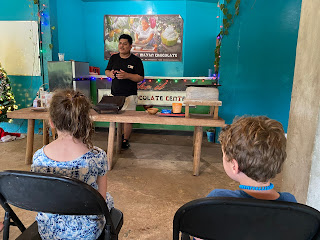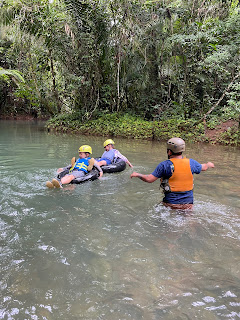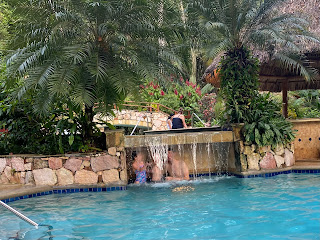Our last night in Hopkins was sublime. By that point, the “storm” we had timed our snorkeling trip around had made landfall. There was a light tropical rain that perfectly set the “last night of the trip” scene. The occasional New Year’s Eve firecracker off in the distance also provided some delightful ambiance. But the holiday also meant that all of our hotel’s golf carts were in use, so we walked into town for dinner. It was a delightful and bittersweet meandering through the homes and shops we had seen all week. But in the rainy twilight, it all looked just a little bit different. It’s not like those golf carts were breaking any speed records, but the slower pace of the walk let us take it all in one last time.
Dinner was at another one of the beach shack restaurants hanging off the back of so many homes in Hopkins. That’s night’s one was just as delightful as every other we had been to that week.
In classic Hopkins charm, the fish and chips that the kids ordered was simply a whole grilled fish surrounded by plantain chips. I pictured the chef seeing the order, shrugging, and saying, “I guess this is what they want.” It was clearly on the menu just for tourists.
Our kids, now quite comfortable with the Central American coastal life, didn’t even seem to notice the difference. They went to town on the dinner, still famished from that morning’s snorkeling adventures.
Aimee took me to the cute little ice cream shop in town for my birthday desert (we never actually did find a bakery). Also in classic Hopkins fashion, they had closed 30 minutes earlier than their posted hours. This was not surprising to us at that point in the trip. But thankfully, the owners (who lived adjacent to the shop) let us grab some prepackaged pints and eat them on the front porch. It was perfect.
Our flight home the next morning was at an infinitely more manageable time than our flight there. So we had a leisurely breakfast in our rental as we packed our bags. The van ride to the airport was easy, the outgoing customs and immigration checks were a breeze, and we begrudgingly boarded our flight to Miami. Although the lunch I ordered at one of the airport cafes took 45 minutes to arrive (again, not a surprise at that point), we made it on board with minimal excitement. But the thought of missing your flight out of Belize is an absolutely stressless situation. My only worry was that we might actually make the flight. I’m sorry to say we did.
Our layover in Miami was scheduled to be 4 hours, which would have been plenty painful on its own. But the holiday traffic ended up extending out the layover to a 5th hour. We were exhausted, but completely fine. There are far greater challenges than hanging out in the Miami airport all evening. The only real story from the layover was a gate agent who gave off the energy you’d expect at 10:30 pm from a gate agent who spent the day working a major holiday. She was in no mood to hear that Aimee and I were in an exit row, which is a no-go when traveling with kids. (The kids themselves were seated 8 rows ahead of us, but I wasn’t particularly concerned about that part.)
With a very heavy sigh, and a “You’re just telling me this now?” she clicked a few keystrokes into her computer and paged a couple of passengers who appeared to be in their early 30s. She asked them, “Do you two want to sit in the exit row?” They of course jumped at the opportunity, which made even more sense as Aimee and I saw where their seats were. Well, I should say that Aimee saw. I was seated up front with Mimi in her original seat, while Aimee and Quinn kept walking back. And walking. And walking.
She finally took her seat in the last row of the plane. It’s never a joy to sit ten inches from the lavatory, but having a seat that didn’t recline while about to embark on a red eye with a 5 year old did not close out our vacation the best note.
We commiserated with each other for a bit over text messaging until the flight attendant announced that the door was closing. The second we turned off our phones, I felt a tap on my shoulder. It was the gate agent (and subject of the letter I had been composing in my mind for the previous 10 minutes). “Call your wife! Tell her row 13! Someone didn’t show!” By that point, Aimee’s phone was off, and I couldn’t catch her eye from (sorry, Aimee) our pretty solid seats at the front bulkhead. So the gate agent went back to tell her. I saw the tears forming in Aimee’s eyes as she gathered up her stuff and hurriedly walked up the aisle with Quinn before the gate agent could change her mind. It was a New Year’s miracle!
We slept as well as anyone could on an overnight flight with two small children. Once we landed (around 2:30 am), we grabbed our bags and went off to the hotel I had already booked. Even before the extended layover, I knew we wouldn’t be in any condition to drive back to Flagstaff that morning. I don’t think I’ve ever enjoyed 4 hours of sleep in an airport hotel more than I did that day.
We grabbed some breakfast, picked up our dog from my mom, and gradually made our way back home. The fresh snow waiting for us was a stark reminder that we weren’t in Belize anymore.
I’m already looking at return flights.






























































